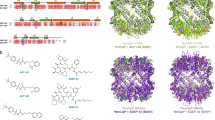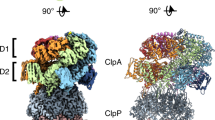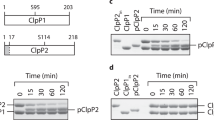Abstract
Clp-family proteins are prototypes for studying the mechanism of ATP-dependent proteases because the proteolytic activity of the ClpP core is tightly regulated by activating Clp-ATPases. Nonetheless, the proteolytic activation mechanism has remained elusive because of the lack of a complex structure. Acyldepsipeptides (ADEPs), a recently discovered class of antibiotics, activate and disregulate ClpP. Here we have elucidated the structural changes underlying the ClpP activation process by ADEPs. We present the structures of Bacillus subtilis ClpP alone and in complex with ADEP1 and ADEP2. The structures show the closed-to-open-gate transition of the ClpP N-terminal segments upon activation as well as conformational changes restricted to the upper portion of ClpP. The direction of the conformational movement and the hydrophobic clustering that stabilizes the closed structure are markedly different from those of other ATP-dependent proteases, providing unprecedented insights into the activation of ClpP.
This is a preview of subscription content, access via your institution
Access options
Subscribe to this journal
Receive 12 print issues and online access
$189.00 per year
only $15.75 per issue
Buy this article
- Purchase on Springer Link
- Instant access to full article PDF
Prices may be subject to local taxes which are calculated during checkout






Similar content being viewed by others
References
Sauer, R.T. et al. Sculpting the proteome with AAA+ proteases and disassembly machines. Cell 119, 9–18 (2004).
Baker, T.A. & Sauer, R.T. ATP-dependent proteases of bacteria: recognition logic and operating principles. Trends Biochem. Sci. 31, 647–653 (2006).
Wickner, S., Maurizi, M.R. & Gottesman, S. Posttranslational quality control: folding, refolding, and degrading proteins. Science 286, 1888–1893 (1999).
Gottesman, S. Proteolysis in bacterial regulatory circuits. Annu. Rev. Cell Dev. Biol. 19, 565–587 (2003).
Joshi, S.A., Hersch, G.L., Baker, T.A. & Sauer, R.T. Communication between ClpX and ClpP during substrate processing and degradation. Nat. Struct. Mol. Biol. 11, 404–411 (2004).
Yu, A.Y. & Houry, W.A. ClpP: a distinctive family of cylindrical energy-dependent serine proteases. FEBS Lett. 581, 3749–3757 (2007).
Park, E.Y. & Song, H.K. A degradation signal recognition in prokaryotes. J. Synchrotron Radiat. 15, 246–249 (2008).
Kirstein, J., Moliere, N., Dougan, D.A. & Turgay, K. Adapting the machine: adaptor proteins for Hsp100/Clp and AAA+ proteases. Nat. Rev. Microbiol. 7, 589–599 (2009).
Kim, D.Y. & Kim, K.K. Crystal structure of ClpX molecular chaperone from Helicobacter pylori. J. Biol. Chem. 278, 50664–50670 (2003).
Jenal, U. & Hengge-Aronis, R. Regulation by proteolysis in bacterial cells. Curr. Opin. Microbiol. 6, 163–172 (2003).
Brotz-Oesterhelt, H. et al. Dysregulation of bacterial proteolytic machinery by a new class of antibiotics. Nat. Med. 11, 1082–1087 (2005).
Hinzen, B. et al. Medicinal chemistry optimization of acyldepsipeptides of the enopeptin class antibiotics. ChemMedChem 1, 689–693 (2006).
Kirstein, J. et al. The antibiotic ADEP reprogrammes ClpP, switching it from a regulated to an uncontrolled protease. EMBO Mol. Med. 1, 37–49 (2009).
Kim, Y.I. et al. Molecular determinants of complex formation between Clp/Hsp100 ATPases and the ClpP peptidase. Nat. Struct. Biol. 8, 230–233 (2001).
Bewley, M.C., Graziano, V., Griffin, K. & Flanagan, J.M. The asymmetry in the mature amino-terminus of ClpP facilitates a local symmetry match in ClpAP and ClpXP complexes. J. Struct. Biol. 153, 113–128 (2006).
Kang, S.G., Maurizi, M.R., Thompson, M., Mueser, T. & Ahvazi, B. Crystallography and mutagenesis point to an essential role for the N-terminus of human mitochondrial ClpP. J. Struct. Biol. 148, 338–352 (2004).
Gribun, A. et al. The ClpP double ring tetradecameric protease exhibits plastic ring-ring interactions, and the N termini of its subunits form flexible loops that are essential for ClpXP and ClpAP complex formation. J. Biol. Chem. 280, 16185–16196 (2005).
Szyk, A. & Maurizi, M.R. Crystal structure at 1.9 Å of E. coli ClpP with a peptide covalently bound at the active site. J. Struct. Biol. 156, 165–174 (2006).
Krissinel, E. & Henrick, K. Secondary-structure matching (SSM), a new tool for fast protein structure alignment in three dimensions. Acta Crystallogr. D Biol. Crystallogr. 60, 2256–2268 (2004).
Thompson, M.W., Singh, S.K. & Maurizi, M.R. Processive degradation of proteins by the ATP-dependent Clp protease from Escherichia coli. Requirement for the multiple array of active sites in ClpP but not ATP hydrolysis. J. Biol. Chem. 269, 18209–18215 (1994).
Thompson, M.W., Miller, J., Maurizi, M.R. & Kempner, E. Importance of heptameric ring integrity for activity of Escherichia coli ClpP. Eur. J. Biochem. 258, 923–928 (1998).
Kim, D.Y. & Kim, K.K. The structural basis for the activation and peptide recognition of bacterial ClpP. J. Mol. Biol. 379, 760–771 (2008).
Park, E.Y., Kim, J.A., Kim, H.W., Kim, Y.S. & Song, H.K. Crystal structure of the Bowman-Birk inhibitor from barley seeds in ternary complex with porcine trypsin. J. Mol. Biol. 343, 173–186 (2004).
Song, H.K. & Suh, S.W. Kunitz-type soybean trypsin inhibitor revisited: refined structure of its complex with porcine trypsin reveals an insight into the interaction between a homologous inhibitor from Erythrina caffra and tissue-type plasminogen activator. J. Mol. Biol. 275, 347–363 (1998).
Martin, A., Baker, T.A. & Sauer, R.T. Distinct static and dynamic interactions control ATPase-peptidase communication in a AAA+ protease. Mol. Cell 27, 41–52 (2007).
Sousa, M.C. et al. Crystal and solution structures of an HslUV protease–chaperone complex. Cell 103, 633–643 (2000).
Groll, M. et al. A gated channel into the proteasome core particle. Nat. Struct. Biol. 7, 1062–1067 (2000).
Smith, D.M. et al. Docking of the proteasomal ATPases' carboxyl termini in the 20S proteasome's α ring opens the gate for substrate entry. Mol. Cell 27, 731–744 (2007).
Forster, A., Masters, E.I., Whitby, F.G., Robinson, H. & Hill, C.P. The 1.9 Å structure of a proteasome-11S activator complex and implications for proteasome-PAN/PA700 interactions. Mol. Cell 18, 589–599 (2005).
Sousa, M.C., Kessler, B.M., Overkleeft, H.S. & McKay, D.B. Crystal structure of HslUV complexed with a vinyl sulfone inhibitor: corroboration of a proposed mechanism of allosteric activation of HslV by HslU. J. Mol. Biol. 318, 779–785 (2002).
Bochtler, M. et al. The structures of HsIU and the ATP-dependent protease HsIU-HsIV. Nature 403, 800–805 (2000).
Wang, J. et al. Crystal structures of the HslVU peptidase-ATPase complex reveal an ATP-dependent proteolysis mechanism. Structure 9, 177–184 (2001).
Bochtler, M., Ditzel, L., Groll, M., Hartmann, C. & Huber, R. The proteasome. Annu. Rev. Biophys. Biomol. Struct. 28, 295–317 (1999).
Groll, M. et al. Structure of 20S proteasome from yeast at 2.4 Å resolution. Nature 386, 463–471 (1997).
Lowe, J. et al. Crystal structure of the 20S proteasome from the archaeon T. acidophilum at 3.4 A resolution. Science 268, 533–539 (1995).
Kohler, A. et al. The axial channel of the proteasome core particle is gated by the Rpt2 ATPase and controls both substrate entry and product release. Mol. Cell 7, 1143–1152 (2001).
Whitby, F.G. et al. Structural basis for the activation of 20S proteasomes by 11S regulators. Nature 408, 115–120 (2000).
Smith, D.M. et al. ATP binding to PAN or the 26S ATPases causes association with the 20S proteasome, gate opening, and translocation of unfolded proteins. Mol. Cell 20, 687–698 (2005).
Rabl, J. et al. Mechanism of gate opening in the 20S proteasome by the proteasomal ATPases. Mol. Cell 30, 360–368 (2008).
Park, E.Y. et al. Structural basis of SspB-tail recognition by the zinc binding domain of ClpX. J. Mol. Biol. 367, 514–526 (2007).
Minor, W., Tomchick, D. & Otwinowski, Z. Strategies for macromolecular synchrotron crystallography. Structure 8, R105–R110 (2000).
Vagin, A. & Teplyakov, A. An approach to multi-copy search in molecular replacement. Acta Crystallogr. D Biol. Crystallogr. 56, 1622–1624 (2000).
Jones, T.A., Zou, J.-Y., Cowan, S.W. & Kjeldgaard, M. Improved methods for binding protein models in electron density maps and the location of errors in these models. Acta Crystallogr. A 47, 110–119 (1991).
Brunger, A.T. et al. Crystallography & NMR system: A new software suite for macromolecular structure determination. Acta Crystallogr. D Biol. Crystallogr. 54, 905–921 (1998).
Emsley, P. & Cowtan, K. Coot: model-building tools for molecular graphics. Acta Crystallogr. D Biol. Crystallogr. 60, 2126–2132 (2004).
Ludtke, S.J., Baldwin, P.R. & Chiu, W. EMAN: semiautomated software for high-resolution single-particle reconstructions. J. Struct. Biol. 128, 82–97 (1999).
Acknowledgements
We thank the staff at 4A beamline, Pohang Accelerator Laboratory, Korea and NW12 beamline, Photon Factory, Japan for help with data collection, B. Hinzen and S. Raddatz (Bayer HealthCare) for the synthesis of ADEPs, M.J. Eck (Dana Farber Cancer Institute) for critical comments on the manuscript and the Advanced Analysis Center in Korea Institute of Science and Technology for providing a transmission electron microscope. This work was supported by the 21C Frontier Functional Proteomics Project (FPR08B2-270), a Korea Research Foundation Grant (KRF-2007-314-C00176), the World Class University project (R33-10108) and the Plant Signaling Network Research Center. This work was also supported by a Korea Institute of Science and Technology Institutional Grant, by the Systems Biology Infrastructure Establishment Grant provided by Gwangju Institute of Science & Technology to H.J. and by a grant of the Deutsche Forschungsgemeinschaft (FOR854) to H.B.-O. B.-G.L. was supported by a Seoul Science Fellowship and a Korean Student Aid Foundation Science Graduate Research Scholarship.
Author information
Authors and Affiliations
Contributions
B.-G.L. and H.K.S. performed X-ray studies; K.-E.L. and H.J. performed electron microscopy studies; B.-G.L. and E.Y.P. performed biochemical studies; K.H.S., H.P. and H.R.-S. performed additional experiments; B.-G.L., H.B.-O. and H.K.S. analyzed data and wrote the manuscript.
Corresponding author
Ethics declarations
Competing interests
The authors declare no competing financial interests.
Supplementary information
Supplementary Text and Figures
Supplementary Figures 1–11, Supplementary Tables 1–3 and Supplementary Data (PDF 2034 kb)
Rights and permissions
About this article
Cite this article
Lee, BG., Park, E., Lee, KE. et al. Structures of ClpP in complex with acyldepsipeptide antibiotics reveal its activation mechanism. Nat Struct Mol Biol 17, 471–478 (2010). https://doi.org/10.1038/nsmb.1787
Received:
Accepted:
Published:
Issue Date:
DOI: https://doi.org/10.1038/nsmb.1787
This article is cited by
-
Anti-infective therapy using species-specific activators of Staphylococcus aureus ClpP
Nature Communications (2022)
-
ClpP inhibitors are produced by a widespread family of bacterial gene clusters
Nature Microbiology (2022)
-
Mitochondrial ClpP serine protease-biological function and emerging target for cancer therapy
Cell Death & Disease (2020)
-
Over-activation of a nonessential bacterial protease DegP as an antibiotic strategy
Communications Biology (2020)
-
Molecular and structural insights into an asymmetric proteolytic complex (ClpP1P2) from Mycobacterium smegmatis
Scientific Reports (2019)



